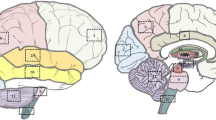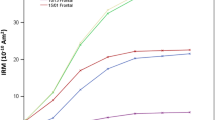Abstract
Using inductively coupled plasma-mass spectrometry after samples microwave-assisted acid digestion, zinc (Zn), copper (Cu), and manganese (Mn) levels were measured in 14 different areas of the human brain of adult individuals (n = 42; 71 ± 12, range 50–101 years old) without a known history of neurodegenerative, neurological, or psychiatric disorder. The main goals of the work were to establish the “normal” (reference) values for those elements in the human brain and to evaluate the age-related changes, a prior and indispensable step in order to enlighten the role of trace element (TE) in human brain physiology and their involvement in aging and neurodegenerative processes. Considering the mean values for the 14 regions, Zn (mean ± sd; range 53 ± 5; 43–61 μg/g) was found at higher levels, followed by Cu (22 ± 5; 10–37 μg/g) and Mn (1.3 ± 0.3; 0.5–2.7 μg/g). The TE distribution across the brain tissue showed to be quite heterogeneous: the highest levels of Zn were found in the hippocampus (70 ± 10; 49–95 μg/g) and superior temporal gyrus (68 ± 10; 44–88 μg/g) and the lowest in the pons (33 ± 8; 19–51 μg/g); the highest levels of Cu and Mn were found in the putamen (36 ± 13; 21–76 μg/g and 2.5 ± 0.8; 0.7–4.5 μg/g, respectively) and the lowest in the medulla (11 ± 6; 2–30 μg/g and 0.8 ± 0.3; 0.2–1.8 μg/g, respectively). A tendency for an age-related increase in Zn and Mn levels was observed in most brain regions while Cu levels showed to be negatively correlated with age.





Similar content being viewed by others
References
National Institute on Aging/US National Institutes of Health and WHO (2011) Global health and aging report. NIH Publication no 11–7737
Castellani RJ, Rolston RK, Smith MA (2010) Alzheimer disease. Dis Mon 56(9):484–546
Jomova K, Vondrakova D, Lawson M, Valko M (2010) Metals, oxidative stress and neurodegenerative disorders. Mol Cell Biochem 345(1–2):91–104
Rivera-Mancia S, Perez-Neri I, Rios C, Tristan-Lopez L, Rivera-Espinosa L, Montes S (2010) The transition metals copper and iron in neurodegenerative diseases. Chem Biol Interact 186(2):184–199
Schrag M, Mueller C, Oyoyo U, Smith MA, Kirsch WM (2011) Iron, zinc and copper in the Alzheimer’s disease brain: a quantitative meta-analysis. Some insight on the influence of citation bias on scientific opinion. Prog Neurobiol 94(3):296–306
Mocchegiani E, Bertoni-Freddari C, Marcellini F, Malavolta M (2005) Brain, aging and neurodegeneration: role of zinc ion availability. Prog Neurobiol 75(6):367–390
Frederickson CJ, Suh SW, Silva D, Frederickson CJ, Thompson RB (2000) Importance of zinc in the central nervous system: the zinc-containing neuron. J Nutr 130(5S Suppl):1471s–1483s
Scheiber IF, Mercer JF, Dringen R (2014) Metabolism and functions of copper in brain. Prog Neurobiol 116:33–57
Takeda A (2003) Manganese action in brain function. Brain Res Brain Res Rev 41(1):79–87
Barnham KJ, Bush AI (2008) Metals in Alzheimer’s and Parkinson’s diseases. Curr Opin Chem Biol 12(2):222–228
Castellani RJ, Honda K, Zhu X, Cash AD, Nunomura A, Perry G, Smith MA (2004) Contribution of redox-active iron and copper to oxidative damage in Alzheimer disease. Ageing Res Rev 3(3):319–326
Bowman AB, Kwakye GF, Herrero Hernández E, Aschner M (2011) Role of manganese in neurodegenerative diseases. J Trace Elem Med Biol 25(4):191–203
Paul MC, Parsons CH, Calford MB, von Nagy-Felsobuki EI (2004) Multi-elemental analysis of brain tissue from healthy Wistar rats using sector field inductively coupled plasma mass spectrometry. Spectrochim Acta B 59(9):1485–1490
Saito T, Itoh T, Fujimura M, Saito K (1995) Age-dependent and region-specific differences in the distribution of trace elements in 7 brain regions of Long-Evans Cinnamon (LEC) rats with hereditary abnormal copper metabolism. Brain Res 695(2):240–244
Hozumi I, Hasegawa T, Honda A, Ozawa K, Hayashi Y, Hashimoto K, Yamada M, Koumura A, Sakurai T, Kimura A, Tanaka Y, Satoh M, Inuzuka T (2011) Patterns of levels of biological metals in CSF differ among neurodegenerative diseases. J Neurol Sci 303(1–2):95–99
Alimonti A, Bocca B, Pino A, Ruggieri F, Forte G, Sancesario G (2007) Elemental profile of cerebrospinal fluid in patients with Parkinson’s disease. J Trace Elem Med Biol 21(4):234–241
Forte G, Bocca B, Senofonte O, Petrucci F, Brusa L, Stanzione P, Zannino S, Violante N, Alimonti A, Sancesario G (2004) Trace and major elements in whole blood, serum, cerebrospinal fluid and urine of patients with Parkinson’s disease. J Neural Transm 111(8):1031–1040
Michalke B, Nischwitz V (2010) Review on metal speciation analysis in cerebrospinal fluid-current methods and results: a review. Anal Chim Acta 682(1–2):23–36
Gellein K, Skogholt JH, Aaseth J, Thoresen GB, Lierhagen S, Steinnes E, Syversen T, Flaten TP (2008) Trace elements in cerebrospinal fluid and blood from patients with a rare progressive central and peripheral demyelinating disease. J Neurol Sci 266(1–2):70–78
Deibel MA, Ehmann WD, Markesbery WR (1996) Copper, iron, and zinc imbalances in severely degenerated brain regions in Alzheimer’s disease: possible relation to oxidative stress. J Neurol Sci 143(1–2):137–142
Hebbrecht G, Maenhaut W, Reuck JD (1999) Brain trace elements and aging. Nucl Instrum Meth B 150(1–4):208–213
Rajan MT, Jagannatha Rao KS, Mamatha BM, Rao RV, Shanmugavelu P, Menon RB, Pavithran MV (1997) Quantification of trace elements in normal human brain by inductively coupled plasma atomic emission spectrometry. J Neurol Sci 146(2):153–166
Andrási E, Igaz S, Szoboszlai N, Farkas É, Ajtony Z (1999) Several methods to determine heavy metals in the human brain. Spectrochim Acta B 54(5):819–825
Ramos P, Santos A, Pinto NR, Mendes R, Magalhães T, Almeida A (2014) Iron levels in the human brain: a post-mortem study of anatomical region differences and age-related changes. J Trace Elem Med Biol 28(1):13–17
Bilgic B, Pfefferbaum A, Rohlfing T, Sullivan EV, Adalsteinsson E (2012) MRI estimates of brain iron concentration in normal aging using quantitative susceptibility mapping. Neuroimage 59(3):2625–2635
Gorell JM, Ordidge RJ, Brown GG, Deniau JC, Buderer NM, Helpern JA (1995) Increased iron-related MRI contrast in the substantia nigra in Parkinson’s disease. Neurology 45(6):1138–1143
Segovia G, Porras A, Del Arco A, Mora F (2001) Glutamatergic neurotransmission in aging: a critical perspective. Mech Ageing Dev 122(1):1–29
Paine SML, Lowe JS (2011) Approach to the post-mortem investigation of neurodegenerative diseases: from diagnosis to research. Diagn Histopathol 17(5):211–216
Broadbent NJ, Squire LR, Clark RE (2004) Spatial memory, recognition memory, and the hippocampus. Proc Natl Acad Sci U S A 101(40):14515–14520
Duflou H, Maenhaut W, De Reuck J (1989) Regional distribution of potassium, calcium, and six trace elements in normal human brain. Neurochem Res 14(11):1099–1112
Lanciego JL, Luquin N, Obeso JA (2012) Functional neuroanatomy of the Basal Ganglia. Cold Spring Harb Perspect Med 2(12)
Andrási E, Farkas E, Gawlik D, Rosick U, Bratter P (2000) Brain iron and zinc contents of German patients with Alzheimer disease. J Alzheimers Dis 2(1):17–26
Kornhuber J, Lange KW, Kruzik P, Rausch WD, Gabriel E, Jellinger K, Riederer P (1994) Iron, copper, zinc, magnesium, and calcium in postmortem brain tissue from schizophrenic patients. Biol Psychiatry 36(1):31–34
Andrási E, Farkas E, Scheibler H, Reffy A, Bezur L (1995) Al, Zn, Cu, Mn and Fe levels in brain in Alzheimer’s disease. Arch Gerontol Geriatr 21(1):89–97
Bonilla E, Salazar E, Villasmil JJ, Villalobos R, Gonzalez M, Davila JO (1984) Copper distribution in the normal human brain. Neurochem Res 9(11):1543–1548
Bonilla E, Salazar E, Villasmil JJ, Villalobos R (1982) The regional distribution of manganese in the normal human brain. Neurochem Res 7(2):221–227
Harrison WW, Netsky MG, Brown MD (1968) Trace elements in human brain: copper, zinc, iron, and magnesium. Clin Chim Acta 21(1):55–60
Krebs N, Langkammer C, Goessler W, Ropele S, Fazekas F, Yen K, Scheurer E (2014) Assessment of trace elements in human brain using inductively coupled plasma mass spectrometry. J Trace Elem Med Biol 28(1):1–7
Hock A, Demmel U, Schicha H, Kasperek K, Feinendegen LE (1975) Trace element concentration in human brain. Activation analysis of cobalt, iron, rubidium, selenium, zinc, chromium, silver, cesium, antimony and scandium. Brain J Neurol 98(1):49–64
Tohno Y, Tohno S, Azuma C, Minami T, Ke L, Ongkana N, Sinthubua A, Mahakkanukrauh P (2013) Mineral composition of and the relationships between them of human basal ganglia in very old age. Biol Trace Elem Res 151(1):18–29
Smart TG, Hosie AM, Miller PS (2004) Zn2+ ions: modulators of excitatory and inhibitory synaptic activity. Neurosci Rev J Bring Neurobiol, Neurol Psychiatr 10(5):432–442
Watt NT, Griffiths HH, Hooper NM (2013) Neuronal zinc regulation and the prion protein. Prion 7(3):203–208
Mocchegiani E, Malavolta M (2007) Zinc dyshomeostasis, ageing and neurodegeneration: implications of A2M and inflammatory gene polymorphisms. J Alzheimers Dis 12(1):101–109
Craddock TJ, Tuszynski JA, Chopra D, Casey N, Goldstein LE, Hameroff SR, Tanzi RE (2012) The zinc dyshomeostasis hypothesis of Alzheimer’s disease. PLoS One 7(3):e33552
Brouillet EP, Shinobu L, McGarvey U, Hochberg F, Beal MF (1993) Manganese injection into the rat striatum produces excitotoxic lesions by impairing energy metabolism. Exp Neurol 120(1):89–94
Normandin L, Hazell AS (2002) Manganese neurotoxicity: an update of pathophysiologic mechanisms. Metab Brain Dis 17(4):375–387
Rossi L, Arciello M, Capo C, Rotilio G (2006) Copper imbalance and oxidative stress in neurodegeneration. Ital J Biochem 55(3–4):212–221
Wang LM, Becker JS, Wu Q, Oliveira MF, Bozza FA, Schwager AL, Hoffman JM, Morton KA (2010) Bioimaging of copper alterations in the aging mouse brain by autoradiography, laser ablation inductively coupled plasma mass spectrometry and immunohistochemistry. Metall Integrat Biometal sci 2(5):348–353
Klevay LM (2008) Alzheimer’s disease as copper deficiency. Med Hypotheses 70(4):802–807
Malavolta M, Giacconi R, Piacenza F, Santarelli L, Cipriano C, Costarelli L, Tesei S, Pierpaoli S, Basso A, Galeazzi R, Lattanzio F, Mocchegiani E (2010) Plasma copper/zinc ratio: an inflammatory/nutritional biomarker as predictor of all-cause mortality in elderly population. Biogerontology 11(3):309–319
Bartzokis G, Tishler TA, Lu PH, Villablanca P, Altshuler LL, Carter M, Huang D, Edwards N, Mintz J (2007) Brain ferritin iron may influence age- and gender-related risks of neurodegeneration. Neurobiol Aging 28(3):414–423
Xu X, Wang Q, Zhang M (2008) Age, gender, and hemispheric differences in iron deposition in the human brain: an in vivo MRI study. Neuroimage 40(1):35–42
Correia H, Ramos P, Santos A, Pinto NR, Mendes R, Magalhães T, Almeida A (2014) A post-mortem study of the anatomical region differences and age-related changes on Ca and Mg levels in the human brain. Microchem J 113:69–76
Dexter DT, Wells FR, Lees AJ, Agid F, Agid Y, Jenner P, Marsden CD (1989) Increased nigral iron content and alterations in other metal ions occurring in brain in Parkinson’s disease. J Neurochem 52(6):1830–1836
Acknowledgments
The authors thank the Universidade do Porto and Santander Totta for financial support through the project “TRAIN: Trace elements in human brain: age-related changes and anatomic region specific differences” (PP_IJUP 2011 342).
Author information
Authors and Affiliations
Corresponding author
Rights and permissions
About this article
Cite this article
Ramos, P., Santos, A., Pinto, N.R. et al. Anatomical Region Differences and Age-Related Changes in Copper, Zinc, and Manganese Levels in the Human Brain. Biol Trace Elem Res 161, 190–201 (2014). https://doi.org/10.1007/s12011-014-0093-6
Received:
Accepted:
Published:
Issue Date:
DOI: https://doi.org/10.1007/s12011-014-0093-6




